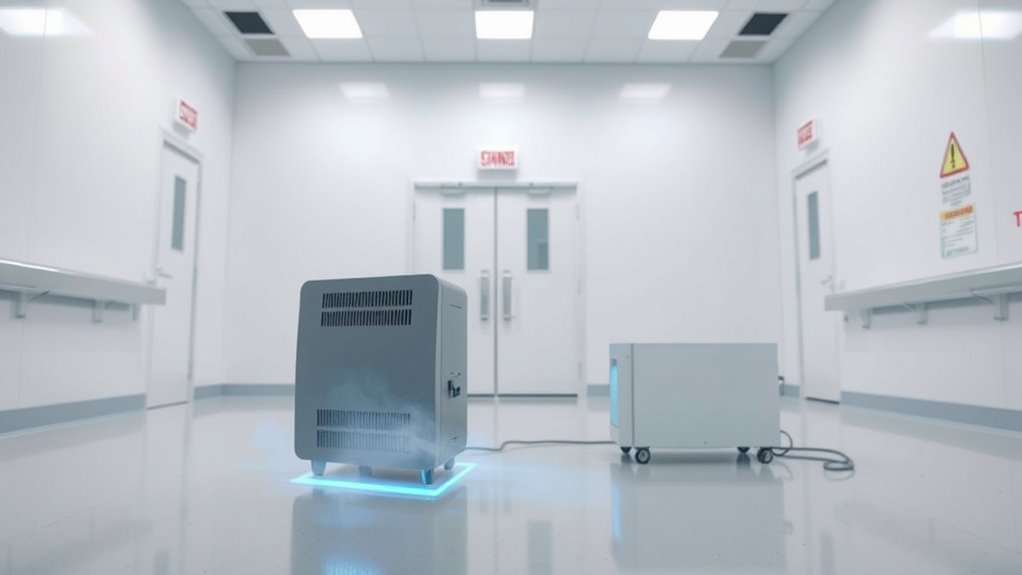Ozone treatment offers a rapid and effective way to eliminate stubborn odors by chemically neutralizing odor molecules, leaving spaces fresher and healthier. However, it can pose health risks like respiratory irritation if not used properly, especially in occupied areas. Proper safety measures—like evacuating the space and ventilating afterward—are essential. While rewarding for deep cleaning, understanding safety guidelines and environmental impacts helps you determine if ozone treatment fits your needs. If you’re interested, there’s more to consider.
Key Takeaways
- Ozone treatment effectively neutralizes stubborn odors by chemically reacting with odor molecules, providing a deep and lasting clean.
- Proper safety measures, such as avoiding occupancy during treatment, are essential to prevent respiratory irritation and health risks.
- Overuse or improper ventilation can lead to ozone accumulation, potentially causing lung irritation and environmental harm.
- Ozone can damage sensitive materials and contribute to ozone depletion if not managed responsibly.
- When used correctly, ozone treatment offers rapid, chemical-free odor removal, but safety and environmental guidelines must be strictly followed.
How Ozone Treatment Works to Eliminate Odors
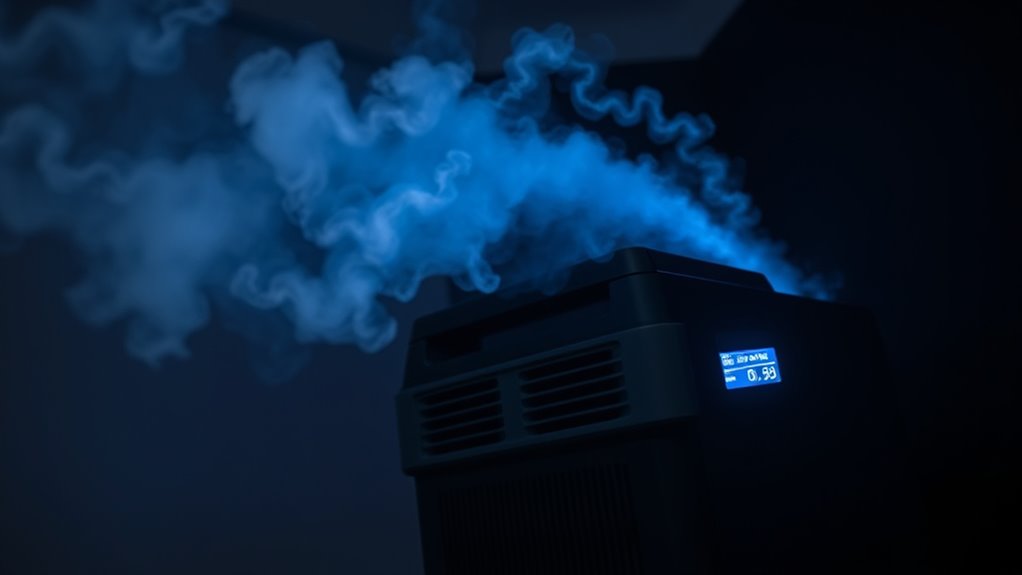
Have you ever wondered how ozone treatment effectively removes stubborn odors? It all starts with the ozone molecule, a powerful form of oxygen composed of three atoms instead of two. When you activate ozone in a space, these molecules seek out odor-causing particles in the air and on surfaces. Through a process called odor neutralization, the ozone molecule reacts with the molecules responsible for bad smells, breaking them down at a molecular level. This reaction transforms the odor molecules into harmless substances like carbon dioxide and water. Unlike masking odors with fragrances, ozone treatment eliminates them entirely. The process is quick and efficient, making it a popular choice for deep cleaning spaces with persistent or strong odors. Additionally, understanding the importance of color accuracy can help optimize the perceived quality of images after treatment in visual environments.
Benefits of Using Ozone for Odor Removal
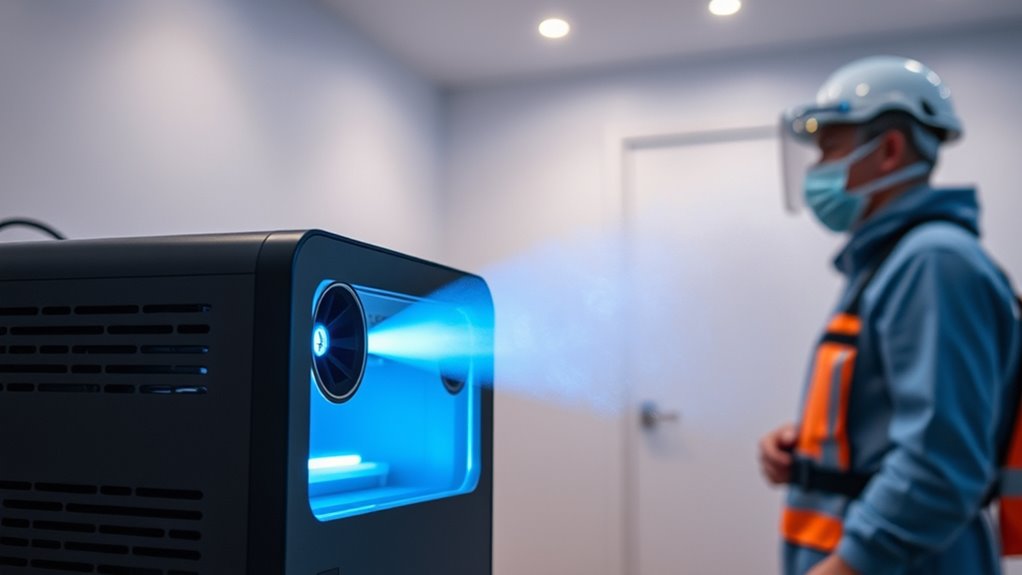
Ozone treatment offers several notable advantages for odor removal that make it a preferred solution for many situations. One key benefit is its ability to enhance air purification by effectively neutralizing even stubborn odors at their source. Unlike chemical deodorization, which masks odors with fragrances, ozone breaks down odor-causing molecules chemically, providing a more lasting solution. This process leaves your environment fresher and healthier without introducing additional chemicals or residues. Ozone’s strong oxidative properties ensure thorough deodorization, making it ideal for spaces affected by smoke, mold, or pet smells. Plus, ozone treatment is typically quick and efficient, allowing you to restore freshness without lengthy procedures. Additionally, understanding industry trends can help you choose the most effective odor removal methods. Overall, these benefits make ozone a powerful tool for achieving cleaner, odor-free spaces.
Potential Health Risks Associated With Ozone Exposure
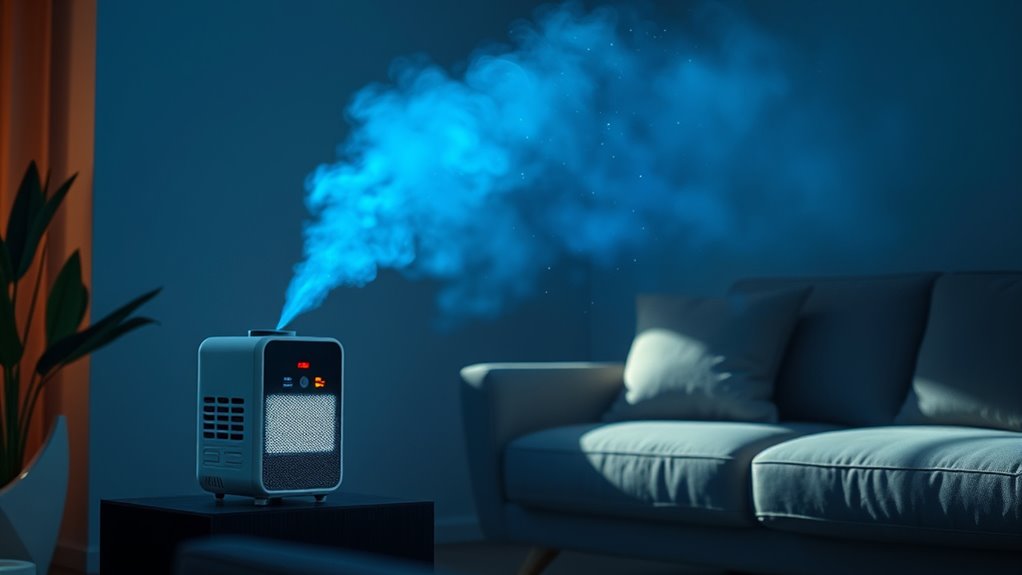
While ozone is effective at eliminating odors, it can pose health risks if not used properly. Exposure to high levels of ozone can irritate your respiratory system, leading to coughing, throat irritation, and shortness of breath. Prolonged or intense exposure may worsen asthma symptoms and harm your indoor air quality. Consider the following impact levels:
| Exposure Level | Symptoms | Duration |
|---|---|---|
| Low | Mild throat irritation | Short-term |
| Moderate | Cough, chest tightness | Several hours |
| High | Respiratory distress, wheezing | Extended exposure |
| Very High | Lung inflammation, damage | Prolonged periods |
Protect your respiratory health by limiting ozone exposure, especially in enclosed spaces. Cookies can help manage your website preferences and ensure safe browsing during air quality concerns.
Safety Precautions When Using Ozone Devices
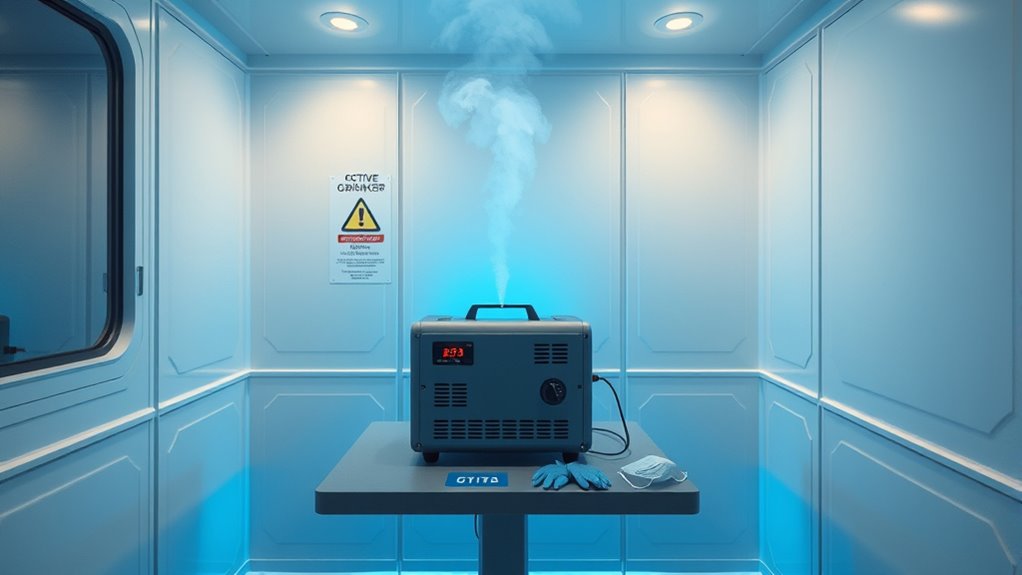
To guarantee your safety when using ozone devices, it’s essential to follow specific precautions that minimize health risks. Always wear protective gear, including respirators and gloves, to prevent ozone exposure. Ensure no one is present in the area during treatment, and keep doors and windows closed. After ozone treatment, implement proper ventilation strategies by opening windows and running fans to disperse residual ozone. Never operate ozone generators in occupied spaces, and wait for the recommended time before re-entering. Use ozone devices according to manufacturer instructions, and avoid shortcuts that could compromise safety. Taking these steps helps protect your respiratory health and reduces the risk of adverse effects from ozone exposure. Transparency in affiliate relationships Safety always comes first when using ozone for odor removal.
Effectiveness of Ozone in Different Environments
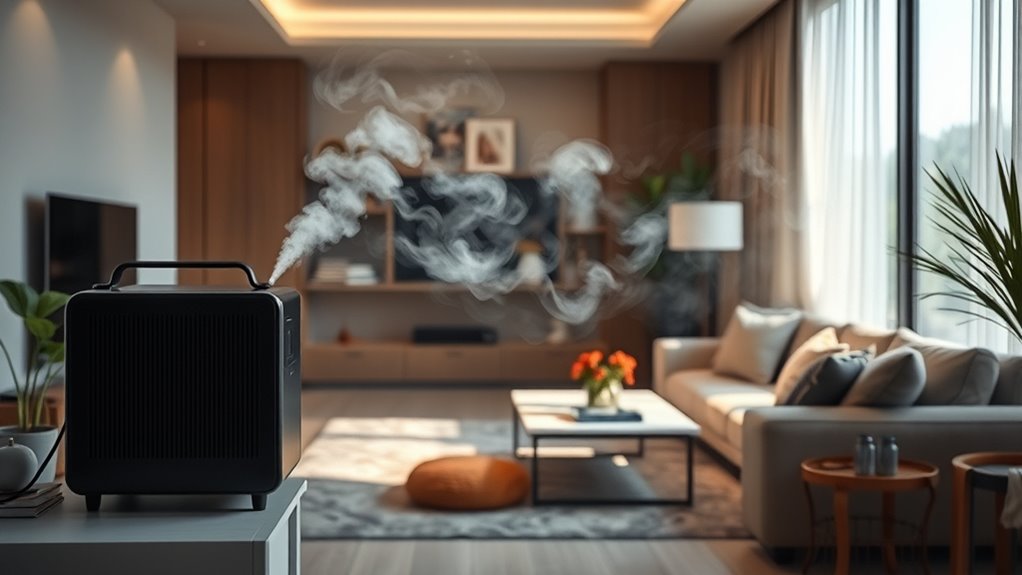
Ozone treatment works well in a variety of settings, from homes to industrial spaces, showing its versatility. However, you should also consider how different environments impact its effectiveness and safety. Environmental impact is key, so understanding how ozone interacts with various surroundings helps optimize its use. Moreover, being aware of privacy policies related to environmental monitoring can help ensure responsible application.
Versatility Across Settings
Ozone’s ability to adapt to various environments demonstrates its remarkable versatility. Whether you’re treating a residential space, commercial property, or industrial setting, ozone effectively neutralizes odors. Its success depends on proper ventilation strategies, which guarantee ozone disperses evenly and safely. In different environments, equipment durability is vital; high-quality ozone generators withstand continuous use without degradation, maintaining consistent performance. You can rely on ozone to tackle stubborn odors in confined areas or large open spaces, making it suitable for diverse applications. Its flexibility allows you to tailor treatment methods based on the setting’s size and ventilation capabilities. This adaptability ensures you get effective odor removal across a broad range of environments, maximizing results while maintaining safety and equipment longevity. Additionally, understanding the bedroom environment helps optimize ozone treatments for specific spaces, ensuring both safety and effectiveness.
Environmental Impact Considerations
While ozone’s versatility allows it to adapt to various environments, understanding its environmental impact is equally important. Ozone treatment can be effective, but it may contribute to ozone depletion if not managed properly, especially when released into the atmosphere. This depletion weakens the ozone layer, increasing ultraviolet radiation exposure and causing ecological consequences like harm to wildlife, plant life, and human health. In enclosed spaces, ozone’s reactive nature can also affect sensitive materials and ecosystems. Consequently, you should consider these factors before deploying ozone generators, particularly outdoors. Proper controls and adherence to safety guidelines can minimize ecological consequences and prevent unnecessary environmental harm while still leveraging ozone’s odor-removing benefits. Additionally, awareness of the Law of Attraction principles can help individuals focus on positive outcomes and responsible practices when using ozone technology.
Comparing Ozone Treatment With Other Odor Removal Methods
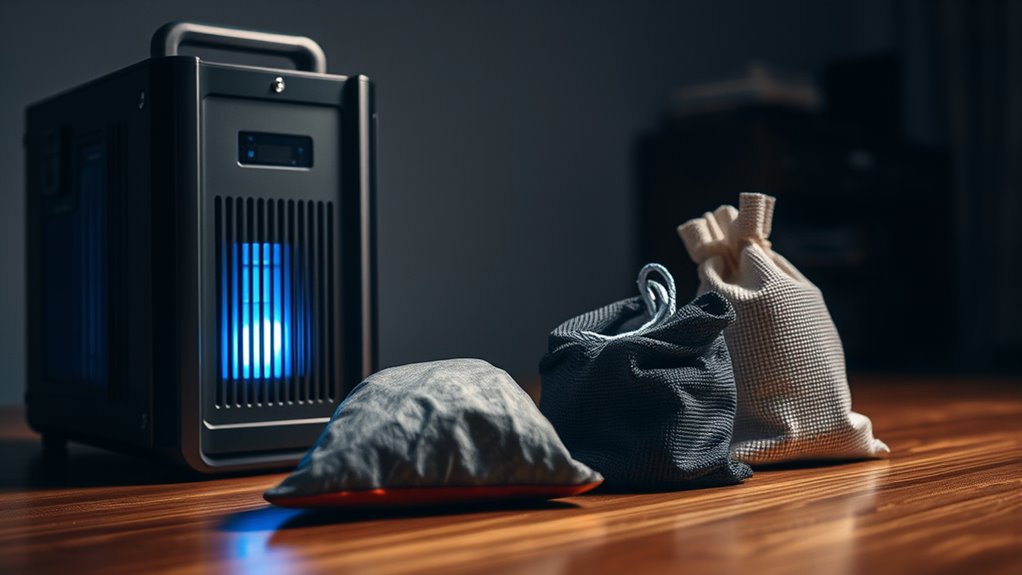
When comparing ozone treatment to other odor removal methods, you’ll notice differences in how quickly and effectively they work. Safety is also a key factor, as some methods may pose more risks or side effects than ozone. Understanding these points helps you choose the best option for your needs. Additionally, while ozone can be highly effective at odor elimination, improper use can lead to health concerns, emphasizing the importance of proper handling and air quality considerations.
Effectiveness and Speed
Compared to other odor removal methods, ozone treatment often works faster and more effectively at neutralizing persistent smells. It quickly enhances air quality by targeting odor molecules directly through powerful chemical reactions. This process transforms stubborn odors into harmless substances in a short time. Consider these key advantages:
- Rapid results—often within hours, not days.
- Deep penetration into hidden areas, unlike surface treatments.
- Effective on a wide range of odors, from smoke to mold.
Ozone’s ability to accelerate chemical reactions breaks down odor-causing compounds efficiently. Because it works swiftly, you experience less disruption and quicker air quality improvement. This makes ozone treatment a compelling choice for those needing fast odor removal from difficult sources.
Safety and Side Effects
Ozone treatment is effective at eliminating odors, but it also raises safety concerns that you should consider. Unlike passive methods like airing out a space or using activated charcoal, ozone can pose risks of chemical exposure if not handled properly. Breathing in high ozone levels can worsen indoor allergies, irritate your lungs, or cause throat discomfort. It’s important to ensure the treated area is well-ventilated and that no people or pets are present during treatment. Other odor removal methods tend to be safer, especially for sensitive individuals. While ozone can quickly neutralize stubborn odors, improper use increases the chance of side effects. Always follow safety guidelines and consider alternative methods if you or your household members have respiratory issues or heightened allergies. Additionally, understanding the benefits of glycolic acid in skin care can help you choose safer, more effective odor and skin treatment options.
Long-Term Impacts on Indoor Air Quality
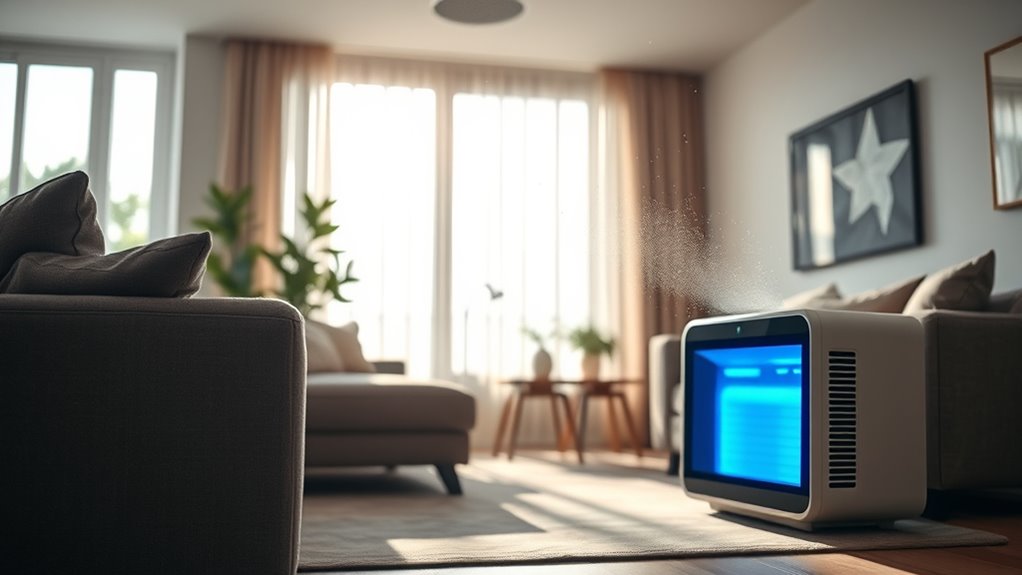
Long-term ozone treatment can substantially influence indoor air quality by altering the levels of pollutants and potentially introducing new health risks. Over time, inadequate indoor ventilation may cause ozone and reaction byproducts to accumulate, impacting your indoor environment. Consider these key effects:
Long-term ozone use can harm indoor air quality and health without proper ventilation.
- Reduced air freshness if ozone reacts with indoor contaminants, creating secondary pollutants.
- Increased health risks from prolonged exposure to ozone and its byproducts, especially in poorly ventilated spaces.
- Degradation of indoor surfaces, which can release additional particles that affect long-term air quality.
Maintaining proper indoor ventilation is essential to mitigate these impacts. Without it, ozone’s effects can linger, reducing long-term air quality and potentially harming your health. Regular airflow and filtration help keep indoor environments safe and fresh.
Regulations and Guidelines for Ozone Use
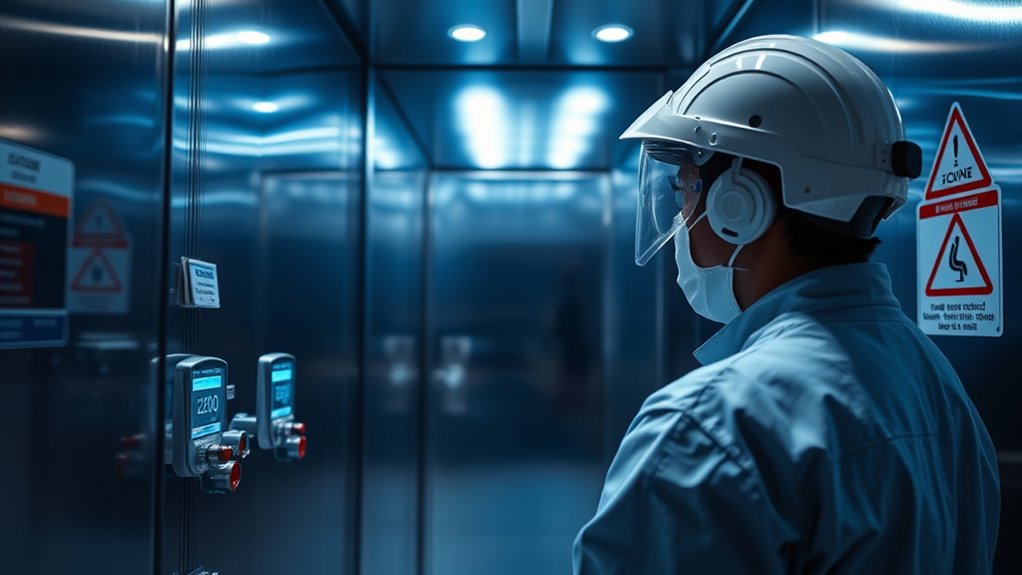
Regulations and guidelines for ozone use are designed to protect public health and guarantee safe application practices. You must confirm legal compliance with local, state, and federal regulations, which specify limits on ozone concentrations and permissible usage scenarios. Industry standards provide additional guidance on safe equipment operation and proper ventilation procedures. Adhering to these regulations helps prevent health risks associated with overexposure, such as respiratory irritation or other adverse effects. Manufacturers and service providers are responsible for following established protocols to maintain safety and effectiveness. Staying informed about current standards ensures you avoid legal penalties and protect your environment. Additionally, understanding ozone concentration limits is crucial to ensure safe implementation of ozone treatments. Ultimately, compliance not only safeguards health but also promotes responsible ozone treatment practices aligned with industry expectations.
Making an Informed Decision: Is Ozone Treatment Right for You?

Deciding whether ozone treatment is right for you involves evaluating your specific needs, concerns, and expectations. Consider these points:
Evaluate your needs and environment carefully before choosing ozone treatment for odor removal.
- If odor absorption is your main goal, ozone can be effective, but it requires proper application for safe air purification.
- For sensitive environments or health concerns, ozone’s risks might outweigh its benefits, making alternative methods preferable.
- If you’re seeking a quick, chemical-free solution for air purification, ozone treatment can deliver results but should be used with caution.
Assess your environment, the type of odors, and potential health impacts. Ozone treatment can be powerful for odor removal, but it’s essential to weigh the risks and benefits to make an informed decision.
Frequently Asked Questions
How Does Ozone Interact Chemically With Different Types of Odors?
When you ask how ozone interacts chemically with odors, you’re exploring its ability to neutralize them. Ozone undergoes chemical reactions with odor molecules, breaking down complex compounds into simpler, less smelly substances. This process, known as odor neutralization, effectively eliminates persistent smells. Ozone’s high reactivity allows it to target a variety of odors, transforming them through these chemical reactions into harmless or less offensive compounds.
Can Ozone Treatment Damage Sensitive Materials Like Artwork or Electronics?
You might wonder if ozone treatment can damage sensitive materials like artwork or electronics. It can pose risks because high ozone levels may cause material sensitivity issues, leading to deterioration or discoloration. Additionally, electronics are vulnerable to ozone-induced damage, which can harm circuits or components. To protect your valuables, it’s best to use ozone treatment carefully, ensuring proper protocols and avoiding exposure to sensitive items.
What Are the Signs of Overexposure to Ozone in Indoor Environments?
You might worry about safety precautions, but it’s vital to recognize signs of overexposure to ozone indoors. Look out for health symptoms like coughing, throat irritation, chest discomfort, or shortness of breath. If these occur, it’s a clear sign you need to ventilate the space and reduce ozone levels. Staying aware of these signs helps protect your health and guarantees safe use of ozone treatments, preventing potential health risks.
How Long Does It Typically Take for Ozone to Completely Remove Odors?
When using ozone for odor removal, the treatment duration depends on factors like ozone concentration and the severity of the smell. Typically, it takes a few hours to a day for ozone to effectively neutralize odors. Higher ozone levels may speed up the process, but you should always monitor treatment time carefully to avoid overexposure. Proper ventilation afterward is essential to guarantee safety and complete odor elimination.
Are There Any Hidden Costs Associated With Ozone Odor Removal Services?
When considering ozone odor removal, you might wonder about hidden costs. Be aware that some services have hidden fees for extra treatments or equipment. Always ask if a service warranty covers any ongoing issues or if additional charges could arise later. By understanding these potential hidden costs upfront, you can make a more informed decision and avoid surprises, ensuring the process remains affordable and effective for your needs.
Conclusion
If you think ozone treatment is just a quick fix, think again—it’s a powerful, potentially risky tool that can completely transform your space or pose serious health hazards if misused. You hold the future of your indoor air quality in your hands, so weigh the dangers and benefits carefully. Don’t underestimate the impact—good or bad—this treatment can have on your environment. Make an informed choice, or risk releasing chaos in your own home!
